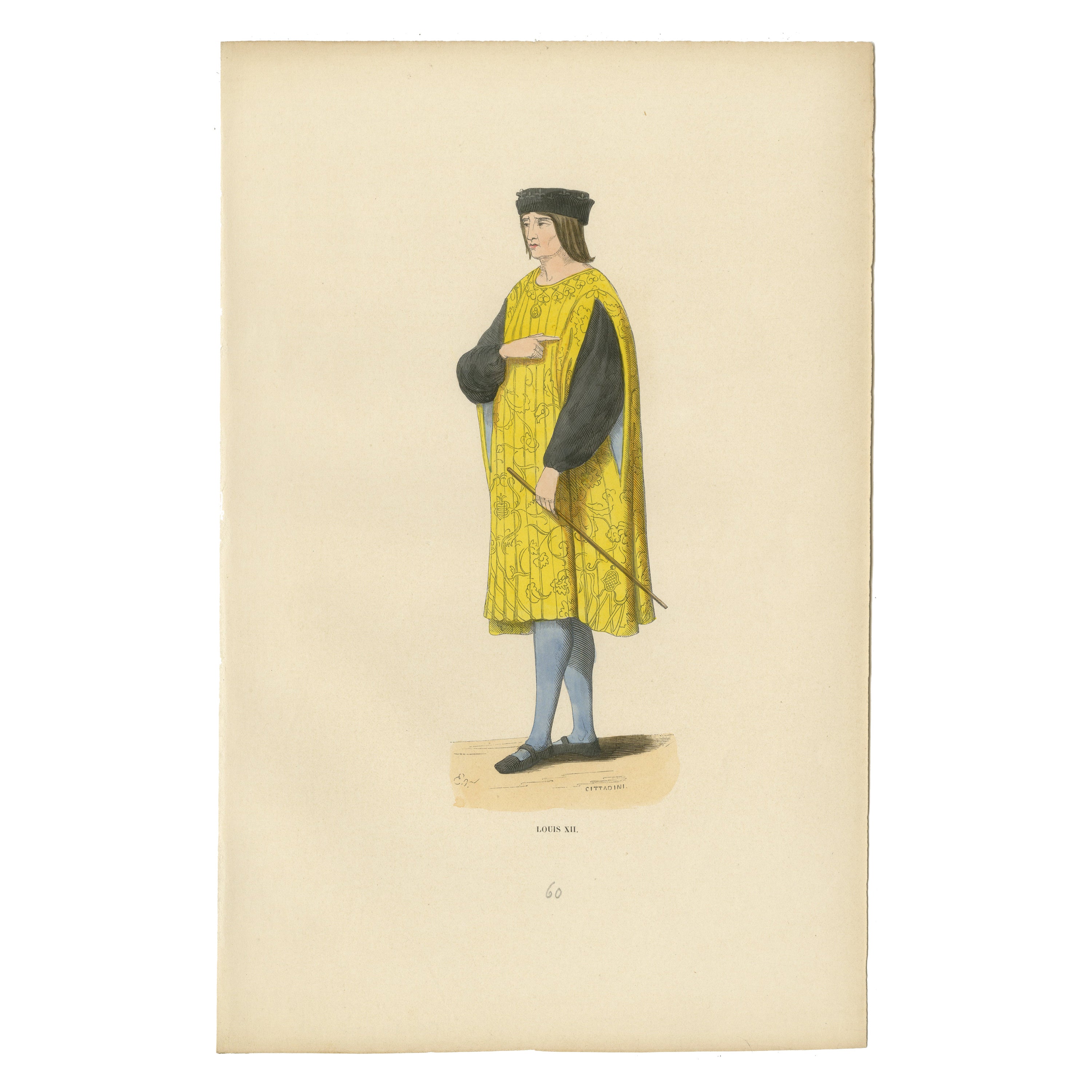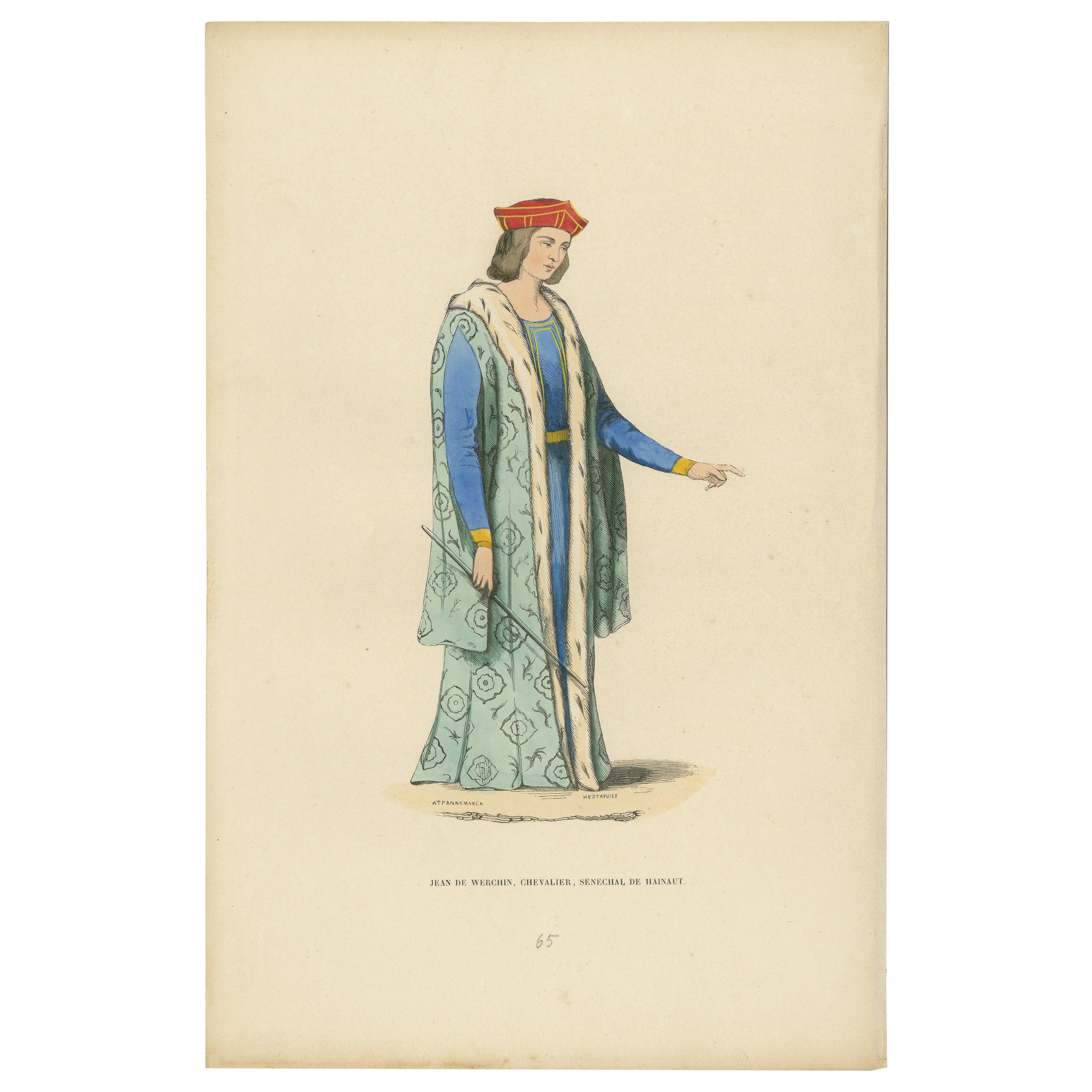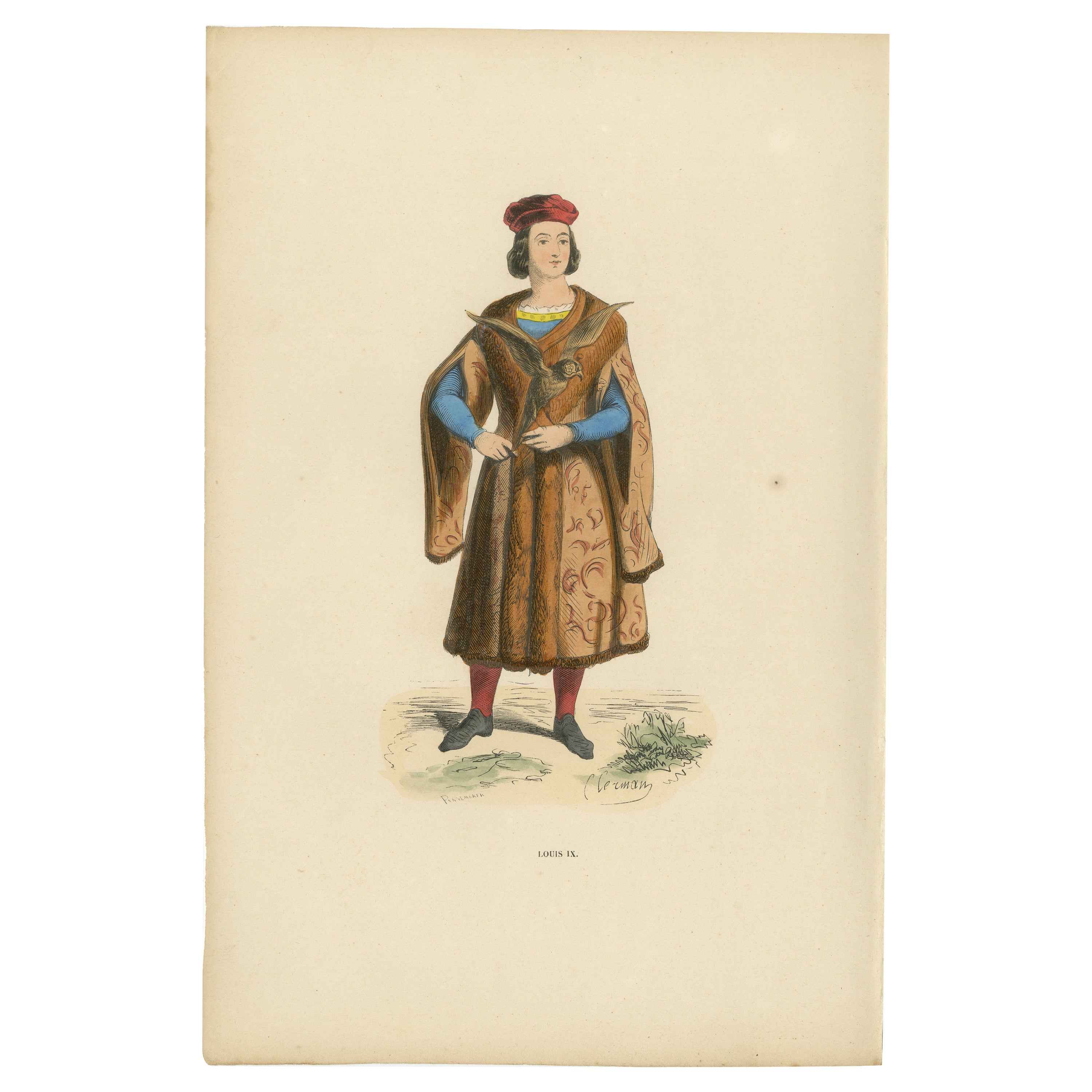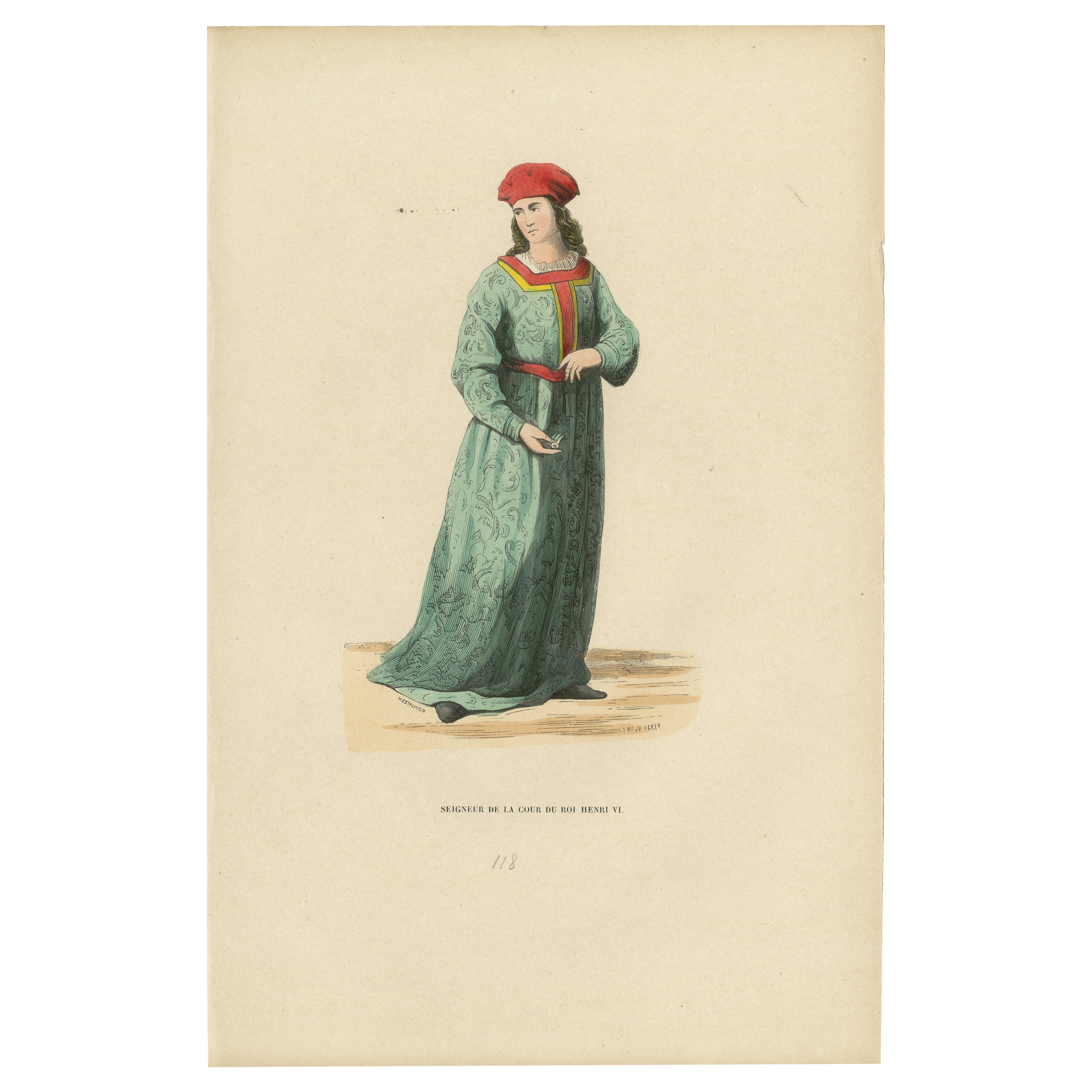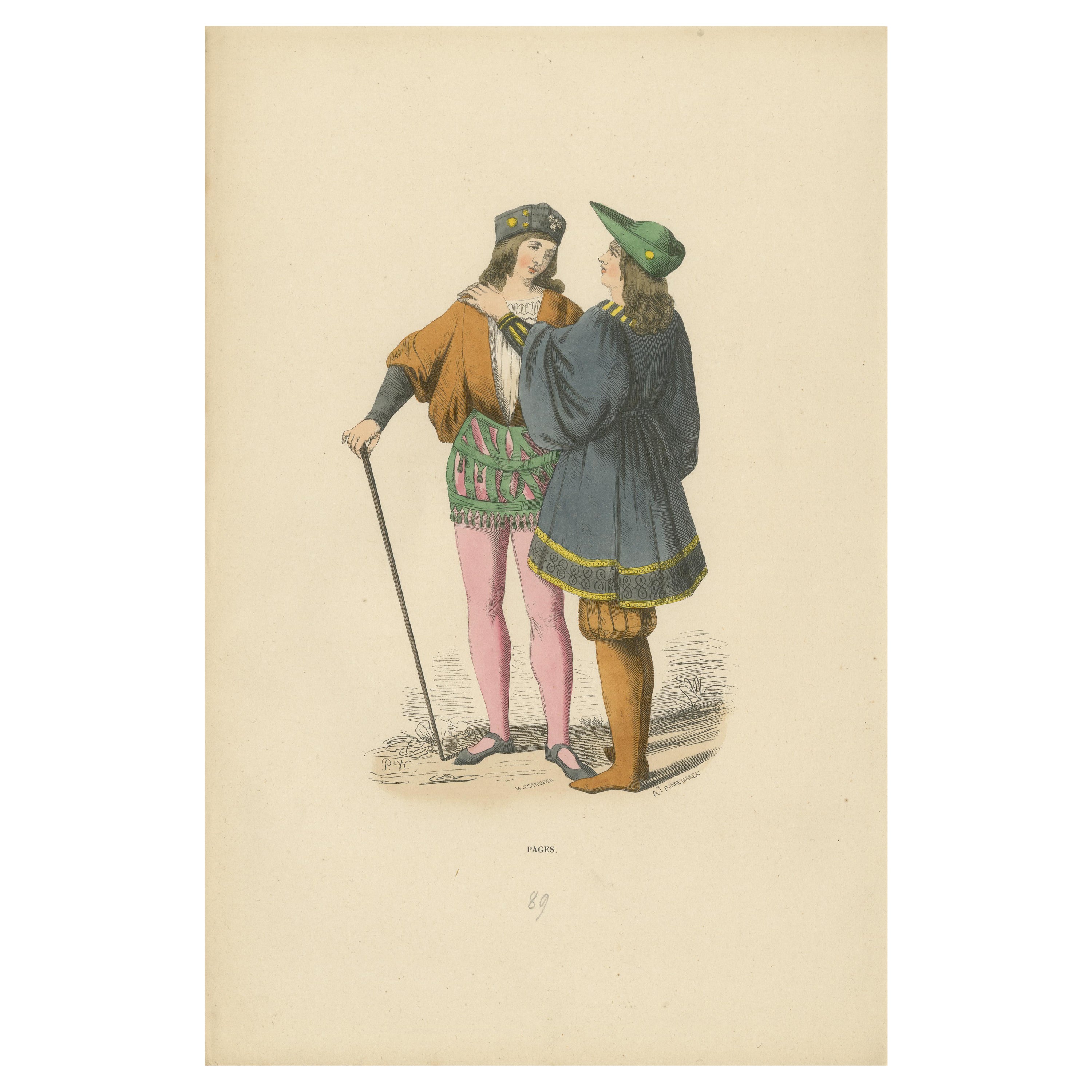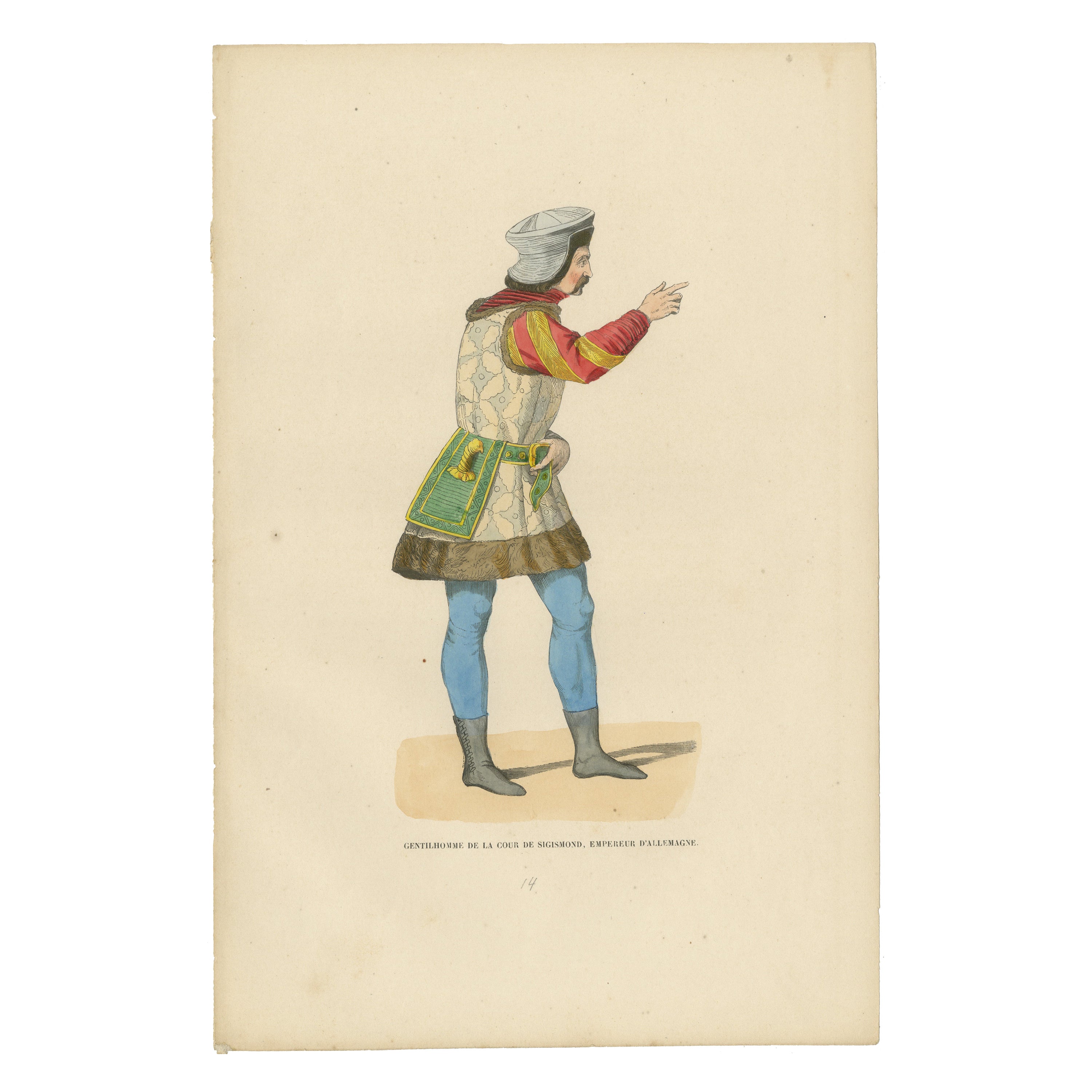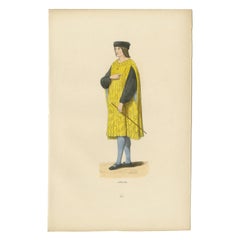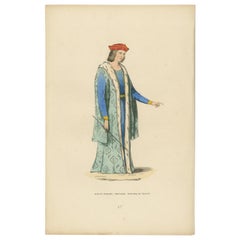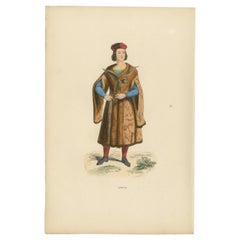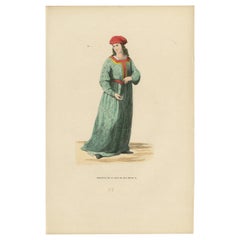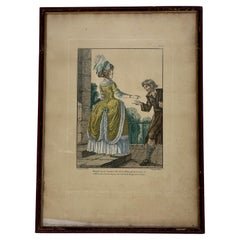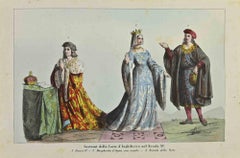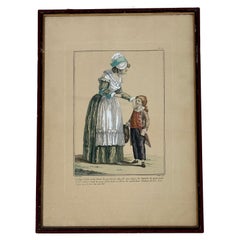Items Similar to Elegance at the Court of Louis XII: A French Noble's Poise, 1847
Want more images or videos?
Request additional images or videos from the seller
1 of 6
Elegance at the Court of Louis XII: A French Noble's Poise, 1847
$134.51
$168.1420% Off
£99.07
£123.8320% Off
€112
€14020% Off
CA$182.99
CA$228.7420% Off
A$203.34
A$254.1820% Off
CHF 106.55
CHF 133.1920% Off
MX$2,493.64
MX$3,117.0520% Off
NOK 1,359.04
NOK 1,698.7920% Off
SEK 1,278.53
SEK 1,598.1620% Off
DKK 852.64
DKK 1,065.8020% Off
Shipping
Retrieving quote...The 1stDibs Promise:
Authenticity Guarantee,
Money-Back Guarantee,
24-Hour Cancellation
About the Item
Title: "Elegance at the Court of Louis XII: A French Noble's Poise"
Description: This delicate historical illustration depicts a French nobleman from the court of King Louis XII, elegantly attired in the fashion of the early 16th century. He stands with a composed and dignified stance, a walking stick in one hand, exuding the grace and refinement expected of someone from his esteemed position.
His attire is a rich blend of colors and textures, indicative of his status. The nobleman wears a soft pink tunic, a color that during the time was often associated with nobility due to the expense of the dye required to produce it. The tunic is complemented by a deep green overcoat with a luxurious fur trim that adds both warmth and a touch of opulence to his ensemble.
The hat, an important status symbol of the time, is fashioned in a black fabric that contrasts with his lighter clothing, completing his attire with a note of seriousness. This hat, along with the belt adorned with a decorative purse, signals his wealth and rank.
The image captures the essence of court life during the reign of Louis XII, a period noted for its artistic and cultural achievements. It is a snapshot of history, reflecting the intricate sartorial customs that were an integral part of the noble identity in the French court. The nobleman's attire is not just clothing but a narrative of status, culture, and the aesthetics of an era where appearance was a key indicator of one's place in the social hierarchy.
The colors have a nice glow over them. Historically, egg whites, known as glair, and sometimes egg yolk were indeed used in illumination and painting, particularly in manuscripts, to give colors a brighter appearance and to add a sheen or gloss to the work. This technique was quite common during the Middle Ages and into the Renaissance.
Egg whites can be applied as a varnish over pigments to enhance their brightness and to protect the colors. This application could make the colors appear more vivid and also add a slight glossy sheen to the surface of the image.
Egg yolk, on the other hand, was commonly used as a binding agent in paint. It forms the basis of tempera paint, a medium that was widely used before the advent of oil painting. Egg yolk helps to create a durable and long-lasting color that adheres well to various surfaces.
In the context of the print from 1847, it's less likely that egg whites or yolks were used directly on the print, as by that time, commercial printing processes would have been more advanced and less reliant on such manual methods. However, if this print is a representation of an earlier style or is meant to mimic the appearance of hand-painted manuscripts, the original artists might have employed techniques or materials that gave a similar effect to those achieved with egg-based binders and varnishes.
- Dimensions:Height: 10.63 in (27 cm)Width: 7.09 in (18 cm)Depth: 0 in (0.02 mm)
- Materials and Techniques:
- Period:
- Date of Manufacture:1847
- Condition:Good. Overal light toning and light soiling but the image itself clean and hand-colored almost 200 years ago and still in expliciet colors. Aged paper with typically warm, yellowish-brown hue, mostly around the edges. Study the images carefully.
- Seller Location:Langweer, NL
- Reference Number:Seller: BG-13635-771stDibs: LU3054337905952
About the Seller
5.0
Recognized Seller
These prestigious sellers are industry leaders and represent the highest echelon for item quality and design.
Platinum Seller
Premium sellers with a 4.7+ rating and 24-hour response times
Established in 2009
1stDibs seller since 2017
2,494 sales on 1stDibs
Typical response time: 1 hour
- ShippingRetrieving quote...Shipping from: Langweer, Netherlands
- Return Policy
Authenticity Guarantee
In the unlikely event there’s an issue with an item’s authenticity, contact us within 1 year for a full refund. DetailsMoney-Back Guarantee
If your item is not as described, is damaged in transit, or does not arrive, contact us within 7 days for a full refund. Details24-Hour Cancellation
You have a 24-hour grace period in which to reconsider your purchase, with no questions asked.Vetted Professional Sellers
Our world-class sellers must adhere to strict standards for service and quality, maintaining the integrity of our listings.Price-Match Guarantee
If you find that a seller listed the same item for a lower price elsewhere, we’ll match it.Trusted Global Delivery
Our best-in-class carrier network provides specialized shipping options worldwide, including custom delivery.More From This Seller
View AllLouis XII: The Prudent King in Regal Attire, 1847
Located in Langweer, NL
This print presents a dignified portrait of Louis XII, King of France, known for his prudent and just reign. Standing in profile, the king is depicted in royal attire that is both la...
Category
Antique 1840s Prints
Materials
Paper
$144 Sale Price
20% Off
Jean de Werchin, a Knight and Seneschal of Hainaut: The Knight's Poise, 1847
Located in Langweer, NL
Title: "Jean de Werchin: The Knight's Poise"
Description: This print illustrates Jean de Werchin, a knight and seneschal of Hainaut, captured in a moment of courtly grace. His postu...
Category
Antique 1840s Prints
Materials
Paper
$115 Sale Price
20% Off
Louis IX: A Portrayal of French Royalty in Medieval Attire, Published in 1847
Located in Langweer, NL
The image is a hand-colored engraving titled "Louis IX," representing the 13th-century King of France, also known as Saint Louis, renowned for his Christian zeal and justice. It is p...
Category
Antique 1840s Prints
Materials
Paper
$163 Sale Price
20% Off
Aristocratic Elegance in the Court of King Henry VI: A Noble Lord Dressep Up
Located in Langweer, NL
Title: "Seigneur de la Cour du Roi Henri VI" (Lord of the Court of King Henry VI)
Description: This hand-colored engraving from the 1847 "Costume du Moyen Age" series represents a nobleman from the court of King Henry VI. The title "Seigneur de la Cour du Roi Henri VI" identifies the subject as a lord or high-ranking individual within the royal court of the 15th-century English monarch.
The lord is portrayed in a long, ornately patterned robe that falls gracefully to the ground, indicative of the elaborate fashion of the high nobility during the time. The garment is colored in a rich teal hue, with a detailed pattern that suggests luxury and status. The robe is trimmed with a contrasting color at the neck and cuffs, and a red belt cinches the robe at the waist, highlighting the layered aspect of medieval...
Category
Antique 1840s Prints
Materials
Paper
$144 Sale Price
20% Off
Confidants of the Court: The Royal Pages, Handcolored and Published in 1847
Located in Langweer, NL
Title: "Confidants of the Court: The Royal Pages"
Description: This artful print portrays two young royal pages in a moment of quiet conversation. The intimate stance and direct eye...
Category
Antique 1840s Prints
Materials
Paper
$134 Sale Price
20% Off
Courtly Splendor: A Nobleman at Emperor Sigismund's Court, 1847
Located in Langweer, NL
The image depicts a man identified as a "Gentilhomme de la cour de Sigismond, empereur d'Allemagne," which translates to "Gentleman of the court of Sigismund, Emperor of Germany."
This individual is portrayed in a profile stance, dressed in attire that is indicative of the high-status courtiers during the time of Emperor Sigismund, who reigned in the early 15th century. He is wearing a turban-like headgear, which reflects the influence of Eastern fashion on European court attire, possibly due to the Ottoman influence or the general exchange of culture during the Crusades and subsequent interactions.
His doublet is richly patterned and he has puffed sleeves in red, which were fashionable among the nobility during the period. The garment is accented with a decorative belt that holds what appears to be a purse or a pouch. He also sports tight blue hose and pointed shoes, which complete the ensemble typical of a nobleman or a high-ranking court official in the Holy Roman Empire.
Egg whites can be applied as a varnish over pigments to enhance their brightness and to protect the colors. This application could make the colors appear more vivid and also add a slight glossy sheen to the surface of the image.
Egg yolk, on the other hand, was commonly used as a binding agent in paint. It forms the basis of tempera paint, a medium that was widely used before the advent of oil painting. Egg yolk helps to create a durable and long-lasting color that adheres well to various surfaces.
In the context of the print from 1847, it's less likely that egg whites or yolks were used directly on the print, as by that time, commercial printing processes would have been more advanced and less reliant on such manual methods. However, if this print is a representation of an earlier style or is meant to mimic the appearance of hand-painted manuscripts...
Category
Antique 1840s Prints
Materials
Paper
$153 Sale Price
20% Off
You May Also Like
Le Impératrice Eugénie Lithograph, c.1850s
Located in Savannah, GA
A large hand-colored lithograph entitled “Le Impératrice, Compiegne,” after the painting by Jean Victor Adam (1801-1866), circa 1850s. Depicted is the Empress Eugénie de Montijo, wi...
Category
Antique Mid-19th Century French Other Prints
Materials
Glass, Wood, Paper
French Engraving Hand Colored Galerie des Modes Costumes Francais, 1779.
Located in Vero Beach, FL
French Engraving Hand Colored Galerie des Modes Costumes Francais, 1779.
Rare antique French fashion print hand colored published first ...
Category
Early 20th Century French Baroque Prints
Materials
Paper
Costumes of the Court of England in the... - Lithograph by Auguste Wahlen - 1844
Located in Roma, IT
Costumes of the Court of England in the 15th century is a lithograph made by Auguste Wahlen in 1844.
Hand colored.
Good condition.
At the center of the artwork is the original tit...
Category
1840s Modern Figurative Prints
Materials
Lithograph
French Engraving Hand Colored Galerie des Modes Costumes Francais, 1779
Located in Vero Beach, FL
French Engraving Hand Colored Galerie des Modes Costumes Francais, 1779
Rare antique French fashion print hand colored published first i...
Category
Early 20th Century French Baroque Prints
Materials
Paper
19th Century Engraving, under Glass, Depicting "the Family Museum"
Located in Saint-Ouen, FR
19th century engraving, under glass, depicting "The Family Museum".
Measures: H 21cm, L 14cm, P 1cm
Category
Antique 1870s French Napoleon III Prints
Materials
Paper
Engravings Representing Le Chateau De Blois Engraved Par Skelton
By Skelton
Located in Saint-Ouen, FR
Engravings representing Le Chateau De Blois engraved Par Skelton and edited by the Musée du Louvres.
Category
20th Century French Louis XV Prints
Materials
Paper
More Ways To Browse
French Print Fabric
Green Egg Used
Fur Hat Used
Pink Fur Hat
Egg Purse
Antique Silver Boxes Repousse
Antique Storm Glass
Antique Thimbles
Antique Victorian Grandfather Clock
Antique Wooden Swan
Art Deco Bed Frame Queen
Art Deco Buffet Mirror
Art Deco Desk Statue
Art Deco Full Bed
Art Deco Glass Shelving
Astronomical Clock
Baker Dining Buffet
Baker Neoclassical Dining
